Kanak Vrindavan Valley
| Location: | Adjoining Amer Fort, On Amer-Jaipur Road |
| Famous for: | Breathtaking views of the cityand plush greenery |
| Built By: | Maharaja Sawai Jai Singh |
| Visiting Hours: | 8:00 AM - 5:00 PM |
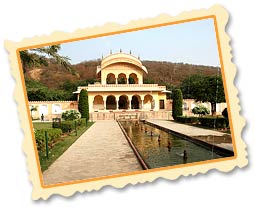 The
Kanak Vrindavan Valley is an exotic place in Jaipur, and is located on
the way to the Amer Fort. Nuzzled at the bottom of the Nahargarh hill,
the garden complex is surrounded by popular tourist spots such as the
Amer Palace, Jaigarh fort and blankets of lush greenery. History states
that the garden was given its name by Maharaja Sawai Jai Singh,
approximately 280 years ago, when the complex was built. The term
'Vrindavan' was coined because the garden resembled the descriptions of a
mythological place, where Lord Krishna is believed to have resided. The
garden is often compared to the valley of 'Vrindavan' and the king,
subsequently, consecrated an idol of Lord Krishna in a special complex
in the Kanak Vrindavan valley called the 'Shri Govind Deoji' complex.
The garden encompasses a temple, a series of fountains and intricate
marble workmanship. Managed by the Government of Rajasthan, the Kanak
Vrindavan Valley is the ideal tourist destination for those wanting to
relish the beautiful, green scenery, and the magnificent structures of a
bygone era.
The
Kanak Vrindavan Valley is an exotic place in Jaipur, and is located on
the way to the Amer Fort. Nuzzled at the bottom of the Nahargarh hill,
the garden complex is surrounded by popular tourist spots such as the
Amer Palace, Jaigarh fort and blankets of lush greenery. History states
that the garden was given its name by Maharaja Sawai Jai Singh,
approximately 280 years ago, when the complex was built. The term
'Vrindavan' was coined because the garden resembled the descriptions of a
mythological place, where Lord Krishna is believed to have resided. The
garden is often compared to the valley of 'Vrindavan' and the king,
subsequently, consecrated an idol of Lord Krishna in a special complex
in the Kanak Vrindavan valley called the 'Shri Govind Deoji' complex.
The garden encompasses a temple, a series of fountains and intricate
marble workmanship. Managed by the Government of Rajasthan, the Kanak
Vrindavan Valley is the ideal tourist destination for those wanting to
relish the beautiful, green scenery, and the magnificent structures of a
bygone era.History
The Kanak Vrindavan Valley was built approximately 280 years ago by Maharaja Sawai Jai Singh of Jaipur. The beautiful, green valley is encircled by the Aravalli hills and is said to resemble mythological Vrindavan; the abode of Lord Krishna and the place where he frolicked with his Gopis. The Kanak Vrindavan Valley was built for recreational purposes by the king. It is also believed to be a sacred spot where the waters from several important rivers merged to carry out the holy 'Ashwamedh Yagna'. The Govind Deoji temple was built around the same time, and is believed to house the incarnation of Lord Krishna.
Layout/Specialty
The Kanak Vrindavan Valley is a picturesque spot located at the foot of the Nahargarh hills, and is flanked by unique trees. Apart from the blankets of trees and lawns, the Kanak Vrindavan Valley is, in fact, a beautiful garden flanked with intricate 'chhatris', exquisite mirror and 'jali' work on the walls of the Govind Deoji temple, and a series of fountains. The garden is divided into eight sections, and is famous for a fountain called 'Parikrama', which is carved out of a single slab of marble. This workmanship from a bygone epoch and the dexterity of the artwork surrounding the garden is what adds to the beauty of the place. The 'Garba Griha' ('seat of the lord') is also placed inside the temple complex and is etched with delicate 'panni' work. The evergreen gardens at the Kanak Vrindavan Valley offer a stupendous view of Jaipur and other nearby attractions such as Amer Fort and the Dharbawati River. The breathtaking scenery has often been used as a background for many Bollywood films in India.
Nearby Tourist Attractions
- Amer Fort
- Jal Mahal
- Elephant Park
- Jaigarh Fort
The Kanak Vrindavan Valley not only offers beautiful
sights for the avid traveler, but is also an ideal location for a picnic
with family. The location also offers a bird's eye view of the city of
Jaipur and its exotic monuments such as the Jal Mahal. For those seeking
tranquility and some peace of mind, the Kanak Vrindavan Valley is the
ideal place to be.
Sisodia Rani Ka Bagh
| Location: | 10 km from Jaipur city |
| Built by: | Maharaja Sawai Jai Singh |
| Built in: | 1728 AD |
| Famous for: | Radha-Krishna Murals |
| Visiting Hours: | 8 AM to 6 PM |
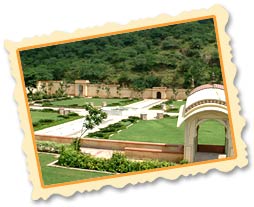 Sisodia
Rani Ka Bagh is situated at a distance of 10 km from Jaipur city and
lies on Jaipur-Agra highway. This royal garden was built by Maharaja
Sawai Jai Singh in 1728 for his second queen Sisodia. Sisodia Rani
Garden is adorned with beautiful wall paintings of Radha-Krishna love
story. The paintings on the wall and the narrative details truly
represent eternal love and befits the essence of this garden which
itself is a symbol of love. This lush green royal garden is replete with
flowerbeds, foliage, beautiful water fountains, pavilions, galleries,
iridescent water channels and murals. It is said that in the olden days,
the garden served as an ideal getaway for the Queen. Sisodia Rani Ka
Bagh is multi-tiered and makes an interesting tourist spot.
Additionally, the garden breathes life to the desert soil of Jaipur.
Sisodia
Rani Ka Bagh is situated at a distance of 10 km from Jaipur city and
lies on Jaipur-Agra highway. This royal garden was built by Maharaja
Sawai Jai Singh in 1728 for his second queen Sisodia. Sisodia Rani
Garden is adorned with beautiful wall paintings of Radha-Krishna love
story. The paintings on the wall and the narrative details truly
represent eternal love and befits the essence of this garden which
itself is a symbol of love. This lush green royal garden is replete with
flowerbeds, foliage, beautiful water fountains, pavilions, galleries,
iridescent water channels and murals. It is said that in the olden days,
the garden served as an ideal getaway for the Queen. Sisodia Rani Ka
Bagh is multi-tiered and makes an interesting tourist spot.
Additionally, the garden breathes life to the desert soil of Jaipur.History Of Sisodia Rani Ka Bagh
Sisodia Rani Ka Bagh was built by Maharaja Sawai Jai Singh in 1728 for his second queen, a princess from Udaipur. The Maharaja presented this royal garden to his beloved queen to serve as a perfect retreat place for her. Away from hustle bustle of court politics, the garden offered a peaceful haven for Sisodia Rani. The garden is filled with various plant species, lush green shrubs and scented flowers. The walls are decorated with murals of Radha-Krishna, symbolizing the love that the Maharaja had for his beloved queen Sisodia.
Architectural Layout
The layout of this royal garden is a beautiful mix of traditional Indian designs and Mughal style. One can see traditional Indian designs, such as the use of pavilions and spires, in the garden. The walls are decked with beautiful paintings of the eternal lovers, Radha and Krishna. The flowerbeds, fountains and water channel running through the garden and merging at the centre are quite symbolic of Mughal style. There are natural springs and shrines dedicated to Lord Shiva, Vishnu and Hanuman in the vicinity of this royal garden.
Best Time To Visit
The best time to visit Sisodia Rani Ka Bagh is between July and March as this is when the state witnesses monsoons followed by winters which are ideal for a visit to Jaipur, known for its extreme climatic conditions.
Nearby Tourist Attractions
The other tourist attractions near Sisodia Rani Ka Bagh are Galtaji Temple, Statue Circle, Birla Temple, Govind Dev Ji Temple, Moti Dungri Ganesh Temple and Jauhari Bazaar.
How To Reach
Sisodia Rani Ka Bagh is well connected to Jaipur by roads and can be reached by local buses that ply from Jaipur to Sisodia Rani Ka Bagh. You can also hire taxi or cab service from Jaipur to reach Sisodia Rani Ka Bagh.
Sisodia Rani Ka Bagh is one of the most favorite tourist destinations in Jaipur city. Here, one can discover a tranquil atmosphere and pavilions adorned with romantic murals of Radha and Krishna. The garden, which was once known as sanctum of Queen Sisodia, can today be enjoyed by everybody who visits it.
Vidyadhar Garden Jaipur
| Famous for: | Murals of Lord Krishna, flower beds, breathtaking scenery and galleries |
| Built In: | 1988 AD |
| Visiting Hours: | 8:00 AM - 5:30 PM(Open all days) |
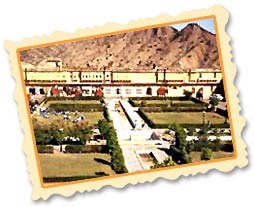 The
Vidyadhar garden is a pristine garden located in the heart of Jaipur.
One of Jaipur's best-preserved gardens, this picturesque garden is
aesthetically designed and was built in the memory of Jaipur's chief
Architect, Vidyadhar Bhattacharya. Apart from the crystal waters, the
tranquil lakes, flower beds and well-maintained gardens, the Vidyadhar
Garden has a lot to offer. Nestled in the lap of a popular valley in
Jaipur, the garden offers a panoramic view of the city and is the pride
of Jaipur's heavy heritage and culture. The garden was strategically
built to the decrees of the ancient 'Shilpa Shasthra' and is situated
close to the Sisodia gardens. The garden is the perfect amalgamation of
contemporary Hindu and Mughal styles with its wonderful, sylvan lakes,
terraced lawns, fountains and the majestic pavilions that house Lord
Krishna's murals and paintings. Managed by the Government of Rajasthan,
the Vidyadhar Garden is a vast expanse of imperial architecture and
dazzling greenery.
The
Vidyadhar garden is a pristine garden located in the heart of Jaipur.
One of Jaipur's best-preserved gardens, this picturesque garden is
aesthetically designed and was built in the memory of Jaipur's chief
Architect, Vidyadhar Bhattacharya. Apart from the crystal waters, the
tranquil lakes, flower beds and well-maintained gardens, the Vidyadhar
Garden has a lot to offer. Nestled in the lap of a popular valley in
Jaipur, the garden offers a panoramic view of the city and is the pride
of Jaipur's heavy heritage and culture. The garden was strategically
built to the decrees of the ancient 'Shilpa Shasthra' and is situated
close to the Sisodia gardens. The garden is the perfect amalgamation of
contemporary Hindu and Mughal styles with its wonderful, sylvan lakes,
terraced lawns, fountains and the majestic pavilions that house Lord
Krishna's murals and paintings. Managed by the Government of Rajasthan,
the Vidyadhar Garden is a vast expanse of imperial architecture and
dazzling greenery.History
The Vidyadhar garden is one of the best-preserved gardens in Jaipur and is also the pride of the city. The garden was built in the memory of Vidyadhar Bhattacharya, who was the architect of the 'Pink City' of Jaipur. As a chief architect to Maharaja Sawai Man Singh, the architect was known for his designs, elaborate architecture and the dexterity with which he could create visual wonders. The garden, built in 1988, was designed according to the ancient texts of the 'Shilpa Shastra', the ancient Indian line of architecture which Vidyadhar used while planning the city of Jaipur. The garden was believed to have been a vineyard, situated in the vicinity of the Sisodia gardens.
Architectural Layout
The Vidyadhar garden is home to beautiful fountains, tiers of terraced gardens, several galleries, royal pavilions and scenic lakes. Built according to the rules of the 'Shilpa Shastra', the Vidyadhar garden also displays ornate frescos with murals and images of Lord Krishna, and well-maintained flower beds. The walls are engraved with intricate lattice work, and mirror work in the temple and the architecture of the place reflects the casual mix of Mughal architecture, with typical Rajput-influenced interiors. The marriage between the two cultures clearly echoes off the landscape and the design of this garden. The garden is known for its numerous fountains, spontaneous peacock dancing, bird watching and the beautifully, terraced flowerbeds.
Nearby Tourist Attractions
- Sisodia Gardens
- City Palace
- Jal Mahal
- Jantar Mantar
The Vidyadhar Garden was constructed in the memory of
Vidyadhar Bhattacharya. The garden is a popular tourist attraction and
is a pleasant getaway for those seeking a peaceful escape. The garden is
a picturesque attraction in the heart of Jaipur and it is a must-see
destination for tourists in this city.
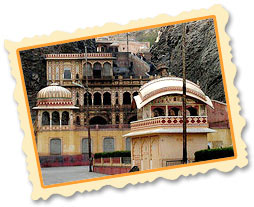 A
pre-historic Hindu pilgrimage site, the Galtaji Temple, is located only
10km away from Jaipur. One of the jewels of Jaipur, the temple complex
encompasses natural fresh water springs and 7 holy 'kunds' or water
tanks. Among these kunds, the 'Galta Kund', is the holiest one and is
believed to never get dry. A spring of pure water flows from the
'Gaumukh', a rock shaped like a cow's head, into the tanks. A
spectacular structure, this magnificent temple is built in pink
sandstone, amidst low hills, and is structured to look more like a
palace or 'haveli' than a traditional temple. The Galta Monkey Temple
has a back-drop of gorgeous landscape featuring lush green vegetation,
and offers a fascinating view of the city of Jaipur. This temple is
famous for the many tribes of monkeys that dwell in this area. The
religious hymns and chants, combined with the natural setting, provide a
peaceful ambience for anyone who visits there.
A
pre-historic Hindu pilgrimage site, the Galtaji Temple, is located only
10km away from Jaipur. One of the jewels of Jaipur, the temple complex
encompasses natural fresh water springs and 7 holy 'kunds' or water
tanks. Among these kunds, the 'Galta Kund', is the holiest one and is
believed to never get dry. A spring of pure water flows from the
'Gaumukh', a rock shaped like a cow's head, into the tanks. A
spectacular structure, this magnificent temple is built in pink
sandstone, amidst low hills, and is structured to look more like a
palace or 'haveli' than a traditional temple. The Galta Monkey Temple
has a back-drop of gorgeous landscape featuring lush green vegetation,
and offers a fascinating view of the city of Jaipur. This temple is
famous for the many tribes of monkeys that dwell in this area. The
religious hymns and chants, combined with the natural setting, provide a
peaceful ambience for anyone who visits there.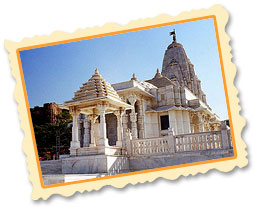 The
Birla Temple, originally known as Lakshmi Narayan Temple, and is
situated below the Moti Dungri Fort in Jaipur. Dedicated to Lord Vishnu
and Goddess Lakshmi, this temple is a proud architectural landmark of
Jaipur. Built in pure white marble, the Birla Temple is unlike the
traditional ancient Hindu temples, and is built with a modern approach.
Inside this magnificent shrine, beautifully sculpted idols of Lord
Vishnu and Goddess Lakshmi, as well as other Hindu Gods and Goddesses,
can be seen. Delicate carvings of Hindu symbols, and ancient quotes from
the Geeta and the Upanishads ornament the walls of this fascinating
temple. One can also recognize the mythological events engraved on the
walls. Apart from the religious idols, pictures and figures of several
religious saints, philosophers and historical achievers, like Socrates,
Buddha, Zarathustra and Confucius, are also included in the temple. A
work of art, this temple truly represents architectural beauty, in a
modern form.
The
Birla Temple, originally known as Lakshmi Narayan Temple, and is
situated below the Moti Dungri Fort in Jaipur. Dedicated to Lord Vishnu
and Goddess Lakshmi, this temple is a proud architectural landmark of
Jaipur. Built in pure white marble, the Birla Temple is unlike the
traditional ancient Hindu temples, and is built with a modern approach.
Inside this magnificent shrine, beautifully sculpted idols of Lord
Vishnu and Goddess Lakshmi, as well as other Hindu Gods and Goddesses,
can be seen. Delicate carvings of Hindu symbols, and ancient quotes from
the Geeta and the Upanishads ornament the walls of this fascinating
temple. One can also recognize the mythological events engraved on the
walls. Apart from the religious idols, pictures and figures of several
religious saints, philosophers and historical achievers, like Socrates,
Buddha, Zarathustra and Confucius, are also included in the temple. A
work of art, this temple truly represents architectural beauty, in a
modern form.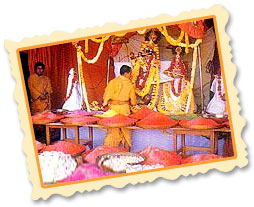 The
temple of Govind Dev Ji is one of the most sacred and famous tourist
destinations in India. It is located in the City Palace complex, in
Jaipur, Rajasthan. The deity, Govind Dev Ji, is none other than Lord
Shri Krishna himself. It is believed that the image in this temple looks
exactly how Lord Krishna looked during his incarnation on earth. The
idol was originally kept in the temple of Vrindavan in Uttar Pradesh and
was later brought to Jaipur by Raja Sawai Jai Singh, a staunch devotee
of Lord Krishna. The idol of Govind Dev Ji is strikingly beautiful for
its complete resemblance with Lord Krishna, and the temple is placed
between Chandra Mahal and Badal Mahal in the City Palace complex. Every
day, various 'Aartis' and 'Prasad' or 'Bhogs' are offered at the temple,
at seven different times. The festival of Janmashtami is among the most
important ones celebrated here as it commemorates the birth of Lord
Krishna.
The
temple of Govind Dev Ji is one of the most sacred and famous tourist
destinations in India. It is located in the City Palace complex, in
Jaipur, Rajasthan. The deity, Govind Dev Ji, is none other than Lord
Shri Krishna himself. It is believed that the image in this temple looks
exactly how Lord Krishna looked during his incarnation on earth. The
idol was originally kept in the temple of Vrindavan in Uttar Pradesh and
was later brought to Jaipur by Raja Sawai Jai Singh, a staunch devotee
of Lord Krishna. The idol of Govind Dev Ji is strikingly beautiful for
its complete resemblance with Lord Krishna, and the temple is placed
between Chandra Mahal and Badal Mahal in the City Palace complex. Every
day, various 'Aartis' and 'Prasad' or 'Bhogs' are offered at the temple,
at seven different times. The festival of Janmashtami is among the most
important ones celebrated here as it commemorates the birth of Lord
Krishna.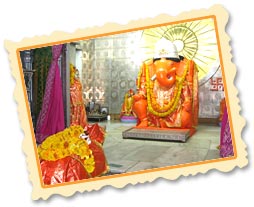 The
Moti Dungri Ganesh Temple was constructed by Seth Jai Ram Paliwal in
the early eighteenth century, and continues to be one the most popular
tourist destinations in Jaipur. Situated in the heart of Jaipur, the
Moti Dungri temple is perched on a small hill, and is surrounded by an
exotic palace. In the recent past, the palace was home to Rajmata Gaytri
Devi, but now, the palace is locked to public, with the temple being
the only tourist location. The highlight of this place is the famous and
auspicious temple of Lord Ganesha, which is frequently visited by the
inhabitants of Jaipur, and other tourists from around the world. In
modern times, it is said that thousands of devotees flock the temple on a
daily basis and it is considered to be one of the most important
religious structures in Jaipur. The temple is nestled by the beautiful
palace, called the Moti Dungri palace, which is an imitation of a
popular Scottish castle.
The
Moti Dungri Ganesh Temple was constructed by Seth Jai Ram Paliwal in
the early eighteenth century, and continues to be one the most popular
tourist destinations in Jaipur. Situated in the heart of Jaipur, the
Moti Dungri temple is perched on a small hill, and is surrounded by an
exotic palace. In the recent past, the palace was home to Rajmata Gaytri
Devi, but now, the palace is locked to public, with the temple being
the only tourist location. The highlight of this place is the famous and
auspicious temple of Lord Ganesha, which is frequently visited by the
inhabitants of Jaipur, and other tourists from around the world. In
modern times, it is said that thousands of devotees flock the temple on a
daily basis and it is considered to be one of the most important
religious structures in Jaipur. The temple is nestled by the beautiful
palace, called the Moti Dungri palace, which is an imitation of a
popular Scottish castle.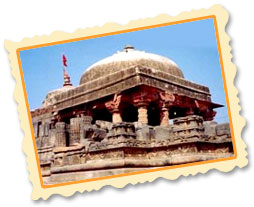 Abhaneri
is a small village of the Dausa district in northern Rajasthan; it is
located 95km from Jaipur, towards the Jaipur-Agra highway. The present
name of the village, 'Abhaneri', is believed to be a mispronunciation of
'Abha Nagri' or the 'city of brightness'. This ancient village in
Rajasthan is renowned for its post-Gupta or early medieval monuments,
Chand Baori and Harshat Mata temple. Though the village is in ruins now,
tourists throng the village to see Chand Baori which is a huge step
well, a unique idea conceived by the natives to work as a water
reservoir. Another attraction is the Harshat Mata temple, an
architectural jewel on the tourism map of Rajasthan. While Harshat Mata
temple symbolises the 10th century architecture, Chand Baori, which is
fortified on all sides, is one of the largest step wells in India.
Abhaneri is also famous for local dances namely Ghoomar, Kalbelia and
Bhawai. Read further to know more about Abhaneri and its attractions.
Abhaneri
is a small village of the Dausa district in northern Rajasthan; it is
located 95km from Jaipur, towards the Jaipur-Agra highway. The present
name of the village, 'Abhaneri', is believed to be a mispronunciation of
'Abha Nagri' or the 'city of brightness'. This ancient village in
Rajasthan is renowned for its post-Gupta or early medieval monuments,
Chand Baori and Harshat Mata temple. Though the village is in ruins now,
tourists throng the village to see Chand Baori which is a huge step
well, a unique idea conceived by the natives to work as a water
reservoir. Another attraction is the Harshat Mata temple, an
architectural jewel on the tourism map of Rajasthan. While Harshat Mata
temple symbolises the 10th century architecture, Chand Baori, which is
fortified on all sides, is one of the largest step wells in India.
Abhaneri is also famous for local dances namely Ghoomar, Kalbelia and
Bhawai. Read further to know more about Abhaneri and its attractions.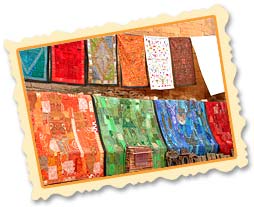 Bagru
is a small village in Rajastan on Jaipur-Ajmer road located at a
distance of 35 kilometers from Jaipur. It's not for any palace or fort
that Bagru is popular; it is the classic wooden block printing of Bagru
which is considered unparalleled. The prints which are popularly known
as 'Bagru Prints' make the village a crafts centre well known in Jaipur
and in surrounding areas. These unique wooden printing techniques employ
wooden blocks where the design is first engraved on the block which is
further used to replicate the design on the preferred fabric. Apart from
this, Bagru craft is also famous for its ecological consciousness and
the use of traditional dyes. The brilliance of this age old craft, which
is kept alive by the natives, makes Bagru a perfect tourist destination
for those people who are crazy about textile printing. Read on to know
more about Bagru and the textile printing that it is famous for.
Bagru
is a small village in Rajastan on Jaipur-Ajmer road located at a
distance of 35 kilometers from Jaipur. It's not for any palace or fort
that Bagru is popular; it is the classic wooden block printing of Bagru
which is considered unparalleled. The prints which are popularly known
as 'Bagru Prints' make the village a crafts centre well known in Jaipur
and in surrounding areas. These unique wooden printing techniques employ
wooden blocks where the design is first engraved on the block which is
further used to replicate the design on the preferred fabric. Apart from
this, Bagru craft is also famous for its ecological consciousness and
the use of traditional dyes. The brilliance of this age old craft, which
is kept alive by the natives, makes Bagru a perfect tourist destination
for those people who are crazy about textile printing. Read on to know
more about Bagru and the textile printing that it is famous for.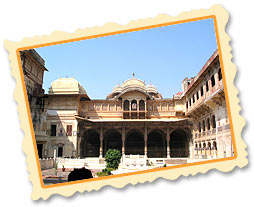 Karauli,
former capital of the erstwhile Karauli state (princely state), is a
small town in the Indian state of Rajasthan. The city has around 300
temples and is hence, regarded as one of the holiest cities of the
state. The city, which is located about 150 km from Jaipur, was founded
by Maharaja Arjun Dev Yadav in 1348 AD. Legend has it that the Jadaun
Rajputs who ruled Karauli were descendants of Lord Krishna. Karauli was
formerly known as Kalyanpuri, named after the deity Kalyanji. The city
is protected by a red sandstone wall constructed all around it. The wall
has gateways at strategic positions, which aided protection from the
approaching enemies in olden days. The wall, though depleted at some
spots, still remains intact. Karauli is famous for its pale red stones
and monuments like the Kaila Devi temple, Madan Mohanji temple and many
other historic structures. Read the following section to know more about
Karauli.
Karauli,
former capital of the erstwhile Karauli state (princely state), is a
small town in the Indian state of Rajasthan. The city has around 300
temples and is hence, regarded as one of the holiest cities of the
state. The city, which is located about 150 km from Jaipur, was founded
by Maharaja Arjun Dev Yadav in 1348 AD. Legend has it that the Jadaun
Rajputs who ruled Karauli were descendants of Lord Krishna. Karauli was
formerly known as Kalyanpuri, named after the deity Kalyanji. The city
is protected by a red sandstone wall constructed all around it. The wall
has gateways at strategic positions, which aided protection from the
approaching enemies in olden days. The wall, though depleted at some
spots, still remains intact. Karauli is famous for its pale red stones
and monuments like the Kaila Devi temple, Madan Mohanji temple and many
other historic structures. Read the following section to know more about
Karauli. Known
for its artificial lake, Ramgarh is situated at a distance of
approximately 35 km from Jaipur city. The lake covers an area of 15.5
sq. km and had once been a major source of water for Jaipur city.
Ramgarh Lake is a manmade water body created by forming an embankment on
the forested hills. The place attracts hundreds and thousands of
tourists every year. During monsoons, the lake is flooded with water and
presents the most alluring scenic beauty for visitors. It is also an
interesting place for bird watchers as they get to see flocks of birds
including migratory birds around this artificial lake. Ever since
Ramgarh was declared a Wildlife Sanctuary by the Government of India in
1982, the place also offers wildlife safaris for the tourists. There are
also polo grounds, Jamwa Mata temple, Old Fort, museum and hunting
lodge to see at Ramgarh. Amidst the ruins of ancient forts, Ramgarh Lake
makes an ideal picnic spot for the visitors.
Known
for its artificial lake, Ramgarh is situated at a distance of
approximately 35 km from Jaipur city. The lake covers an area of 15.5
sq. km and had once been a major source of water for Jaipur city.
Ramgarh Lake is a manmade water body created by forming an embankment on
the forested hills. The place attracts hundreds and thousands of
tourists every year. During monsoons, the lake is flooded with water and
presents the most alluring scenic beauty for visitors. It is also an
interesting place for bird watchers as they get to see flocks of birds
including migratory birds around this artificial lake. Ever since
Ramgarh was declared a Wildlife Sanctuary by the Government of India in
1982, the place also offers wildlife safaris for the tourists. There are
also polo grounds, Jamwa Mata temple, Old Fort, museum and hunting
lodge to see at Ramgarh. Amidst the ruins of ancient forts, Ramgarh Lake
makes an ideal picnic spot for the visitors.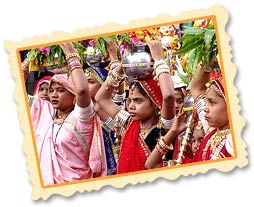 Gangaur
is one of the most vivid festivals rejoiced with great enthusiasm and
happiness all over the Indian state of Rajasthan. In the word Gangaur,
'Gan' is the synonym for Lord Shiva whereas 'Gaur' stands for Gauri or
Goddess Parvati. But mainly, this festival is held in the honour of
Goddess Parvati as she is regarded as the epitome of marital love,
strength, courage, power and excellence. During the festivities, married
women worship Goddess Parvati for the long life, well being and wealth
of their husbands while the girls pray for getting a smart and an
understanding life partner. The festival is rejoiced in the month of
Chaitra, the first month of the Hindu calendar and falls in between
March and April, according to Gregorian calendar. It begins on the very
first day Chaitra month, the day after Holi and is celebrated for 18
days. Also, it marks the end of winter season and the coming of spring
season.
Gangaur
is one of the most vivid festivals rejoiced with great enthusiasm and
happiness all over the Indian state of Rajasthan. In the word Gangaur,
'Gan' is the synonym for Lord Shiva whereas 'Gaur' stands for Gauri or
Goddess Parvati. But mainly, this festival is held in the honour of
Goddess Parvati as she is regarded as the epitome of marital love,
strength, courage, power and excellence. During the festivities, married
women worship Goddess Parvati for the long life, well being and wealth
of their husbands while the girls pray for getting a smart and an
understanding life partner. The festival is rejoiced in the month of
Chaitra, the first month of the Hindu calendar and falls in between
March and April, according to Gregorian calendar. It begins on the very
first day Chaitra month, the day after Holi and is celebrated for 18
days. Also, it marks the end of winter season and the coming of spring
season.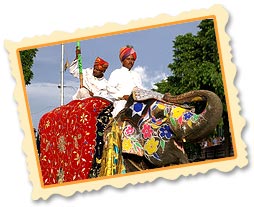 Jaipur,
the land that is always covered with the colours of fairs and
festivals, enchants whoever experiences the glory of fests. Festival of
every religion is celebrated with similar passion and beauty, be it
welcoming or bidding farewell to a season, praying for a healthy life of
the spouse or any other occasion for that matter. Each of these
festivals holds significant position in the lives of people of Jaipur.
One can not only feel the liveliness of people during these festivals,
but can even witness the rich culture of Rajasthan. And one such
festival is Teej, which falls in the monsoon months of July-August. On
this occasion, married women pray to Lord Shiva and Parvati to bless
them with happy and long married life. Celebrated in and around
Rajasthan this festival of swings welcomes monsoon. The swings are
decked with flowers and hung from trees, women dressed in green clothes
make merry and sing songs. This festival that symbolises growth
continues for two days, women observe fasts for the long life of their
husbands and men pray for good rain and crop.
Jaipur,
the land that is always covered with the colours of fairs and
festivals, enchants whoever experiences the glory of fests. Festival of
every religion is celebrated with similar passion and beauty, be it
welcoming or bidding farewell to a season, praying for a healthy life of
the spouse or any other occasion for that matter. Each of these
festivals holds significant position in the lives of people of Jaipur.
One can not only feel the liveliness of people during these festivals,
but can even witness the rich culture of Rajasthan. And one such
festival is Teej, which falls in the monsoon months of July-August. On
this occasion, married women pray to Lord Shiva and Parvati to bless
them with happy and long married life. Celebrated in and around
Rajasthan this festival of swings welcomes monsoon. The swings are
decked with flowers and hung from trees, women dressed in green clothes
make merry and sing songs. This festival that symbolises growth
continues for two days, women observe fasts for the long life of their
husbands and men pray for good rain and crop.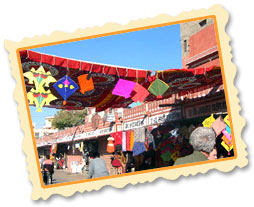 Jaipur
is the land of fairs and festivals. Always dipped in the colours of
festival, this place enchants anyone who experiences the glory of fests.
Festival of every religion is celebrated with same zeal and gusto. Each
festival has its importance, be it welcoming a season, bidding adieu to
a season, wishing long life and good health of the spouse, praise the
Lord, worship trees and animals in the form of God. These festivals are
integral part of the lives of people of Jaipur. One can not only feel
the liveliness of people during these festivals, but can even get a wide
exposure of culture of Rajasthan. These fairs and festival offer you
with a holistic view of the heritage and art of Rajasthan. A prominent
one out of the festivals of Rajasthan is the Kite Festival. Certainly,
it's a festival that is unique in its own way. The colourful kites
hovering over whole of Rajasthan brighten up the skies. This festival is
largely celebrated in Jaipur and Jodhpur. The kites-with-lights flown
add to the fancy of the festival. If you like kite flying, this is the
festival for you. How about visiting Jaipur during this festival? Know
more about this festival before you catch up with the delight of this
festival in Jaipur.
Jaipur
is the land of fairs and festivals. Always dipped in the colours of
festival, this place enchants anyone who experiences the glory of fests.
Festival of every religion is celebrated with same zeal and gusto. Each
festival has its importance, be it welcoming a season, bidding adieu to
a season, wishing long life and good health of the spouse, praise the
Lord, worship trees and animals in the form of God. These festivals are
integral part of the lives of people of Jaipur. One can not only feel
the liveliness of people during these festivals, but can even get a wide
exposure of culture of Rajasthan. These fairs and festival offer you
with a holistic view of the heritage and art of Rajasthan. A prominent
one out of the festivals of Rajasthan is the Kite Festival. Certainly,
it's a festival that is unique in its own way. The colourful kites
hovering over whole of Rajasthan brighten up the skies. This festival is
largely celebrated in Jaipur and Jodhpur. The kites-with-lights flown
add to the fancy of the festival. If you like kite flying, this is the
festival for you. How about visiting Jaipur during this festival? Know
more about this festival before you catch up with the delight of this
festival in Jaipur.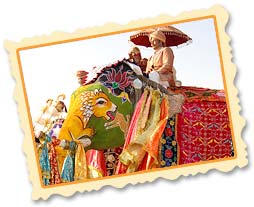 The
Elephant Festival is an annual festival which is held every year in the
Pink City, Jaipur. This matchless event is organised on the full moon
day of Phalgun Purnima which falls in the month of February/March. It is
celebrated on the day before the festivals of colours i.e. Holi. From
the ancient times, elephants have always been an important part of the
Indian society. The Elephant-headed God, Ganesha, believed to be the
remover of obstacles and foremost to all the gods, is revered and
devotedly worshipped in all the parts of India. They are also one of the
most important parts of religious events, marriage ceremonies,
processions, etc. and in the historic time, they were a significant part
of the battlefield.
The
Elephant Festival is an annual festival which is held every year in the
Pink City, Jaipur. This matchless event is organised on the full moon
day of Phalgun Purnima which falls in the month of February/March. It is
celebrated on the day before the festivals of colours i.e. Holi. From
the ancient times, elephants have always been an important part of the
Indian society. The Elephant-headed God, Ganesha, believed to be the
remover of obstacles and foremost to all the gods, is revered and
devotedly worshipped in all the parts of India. They are also one of the
most important parts of religious events, marriage ceremonies,
processions, etc. and in the historic time, they were a significant part
of the battlefield.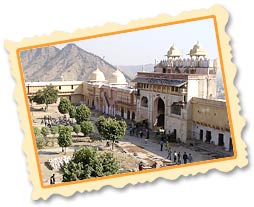 The
Indian state of Rajasthan is famous for its royal heritage. Formed by
the union of many princely states ruled mainly by Rajputs, Rajasthan has
many forts and palaces. Some of these palaces and forts are associated
with important historical events as well. Nahargarh Fort, along with
other two forts viz., Amer Fort and Jaigarh Fort, once formed a strong
defense for Jaipur city. Built by Maharaja Sawai Jai Singh II in 1734,
this fort was originally named Sudarshangarh Fort. Later, it was given a
new name, Nahargarh which means 'abode of tigers'. Located in one of
the oldest mountain ranges of the world, the Aravalli Hills, this fort
gives you a breathtaking view of the scenic surroundings. One of the
major tourist attractions of Jaipur, Nahargarh Fort is noted for its
extended wall which connects it to the Jaigarh Fort.
The
Indian state of Rajasthan is famous for its royal heritage. Formed by
the union of many princely states ruled mainly by Rajputs, Rajasthan has
many forts and palaces. Some of these palaces and forts are associated
with important historical events as well. Nahargarh Fort, along with
other two forts viz., Amer Fort and Jaigarh Fort, once formed a strong
defense for Jaipur city. Built by Maharaja Sawai Jai Singh II in 1734,
this fort was originally named Sudarshangarh Fort. Later, it was given a
new name, Nahargarh which means 'abode of tigers'. Located in one of
the oldest mountain ranges of the world, the Aravalli Hills, this fort
gives you a breathtaking view of the scenic surroundings. One of the
major tourist attractions of Jaipur, Nahargarh Fort is noted for its
extended wall which connects it to the Jaigarh Fort.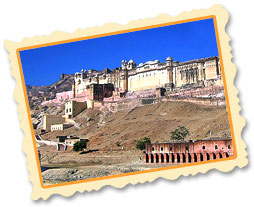 The Amer Fort, situated in Amber, 11 kilometers from Jaipur, is one of the most famous
The Amer Fort, situated in Amber, 11 kilometers from Jaipur, is one of the most famous 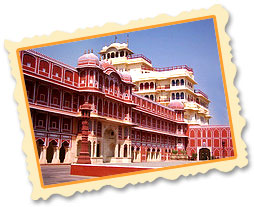 Located
in the heart of the Pink City Jaipur, the City Palace was where the
Maharaja reigned from. This palace also includes the famous 'Chandra
Mahal' and 'Mubarak Mahal', and other buildings which form a part of the
palace complex. The palace is located towards the northeast side of
central Jaipur and has many courtyards and buildings. The palace was
built between 1729 and 1732 AD by Sawai Jai Singh II. He ruled in Amer
and planned and built the outer walls of the palace and later rulers
added to the architecture of this palace. These additions have been
known to take place right up to the 20th century. The urban layout of
the city of Jaipur was commissioned to Vidyadhar Bhattacharya and Sir
Samuel Swinton Jacob. The architectural styles are largely based on a
fusion of Rajput, Mughal and European styles. Today, the 'Chandra Mahal'
has been turned into a museum which is home to unique handcrafted
products, various uniforms of the rulers and many more things pertaining
to the royal heritage of the City Palace.
Located
in the heart of the Pink City Jaipur, the City Palace was where the
Maharaja reigned from. This palace also includes the famous 'Chandra
Mahal' and 'Mubarak Mahal', and other buildings which form a part of the
palace complex. The palace is located towards the northeast side of
central Jaipur and has many courtyards and buildings. The palace was
built between 1729 and 1732 AD by Sawai Jai Singh II. He ruled in Amer
and planned and built the outer walls of the palace and later rulers
added to the architecture of this palace. These additions have been
known to take place right up to the 20th century. The urban layout of
the city of Jaipur was commissioned to Vidyadhar Bhattacharya and Sir
Samuel Swinton Jacob. The architectural styles are largely based on a
fusion of Rajput, Mughal and European styles. Today, the 'Chandra Mahal'
has been turned into a museum which is home to unique handcrafted
products, various uniforms of the rulers and many more things pertaining
to the royal heritage of the City Palace.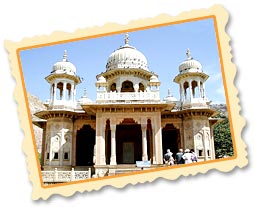 How to Reach:
Gaitore has excellent road connectivity as the place is located on the
Jaipur-Amer road which is 15 km away from the city. People can also hire
autos, taxis or local buses which ply frequently from the city to the
monument.
How to Reach:
Gaitore has excellent road connectivity as the place is located on the
Jaipur-Amer road which is 15 km away from the city. People can also hire
autos, taxis or local buses which ply frequently from the city to the
monument.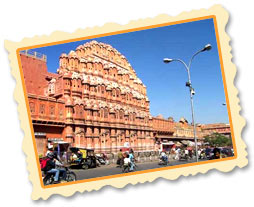 The
renowned 'Palace Of The Winds', or Hawa Mahal, is one of the prominent
tourist attractions in Jaipur city. Located in the heart of Jaipur, this
beautiful five-storey palace was constructed in 1799 by Maharaja Sawai
Pratap Singh who belonged to Kachhwaha Rajput dynasty. The main
architect of this palace built of red and pink sandstone, is Lal Chand
Ustad and the palace is believed to have been constructed in the form of
the crown of Krishna, the Hindu god. Considered as an embodiment of
Rajputana architecture, the main highlight of Hawa Mahal is its pyramid
shape and its 953 windows or 'Jharokhas' which are decorated with
intricate designs. The main intention behind the construction of the
Mahal was to facilitate the royal women and provide them a view of
everyday life through the windows, as they never appeared in public.
Read further to know more about Hawa Mahal, its history, architecture
and its visiting hours.
The
renowned 'Palace Of The Winds', or Hawa Mahal, is one of the prominent
tourist attractions in Jaipur city. Located in the heart of Jaipur, this
beautiful five-storey palace was constructed in 1799 by Maharaja Sawai
Pratap Singh who belonged to Kachhwaha Rajput dynasty. The main
architect of this palace built of red and pink sandstone, is Lal Chand
Ustad and the palace is believed to have been constructed in the form of
the crown of Krishna, the Hindu god. Considered as an embodiment of
Rajputana architecture, the main highlight of Hawa Mahal is its pyramid
shape and its 953 windows or 'Jharokhas' which are decorated with
intricate designs. The main intention behind the construction of the
Mahal was to facilitate the royal women and provide them a view of
everyday life through the windows, as they never appeared in public.
Read further to know more about Hawa Mahal, its history, architecture
and its visiting hours.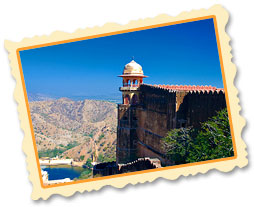 The
Jaigarh Fort is a majestic stronghold built by Sawan Jai Singh II. This
almost-intact fort is surrounded by huge battlements and is connected
to the Amer Fort (also called 'Amber' Fort), with subterranean passages.
Originally built to protect the Amer Fort and the palace within the
complex, the Jaigarh Fort is architecturally similar to the Amer Fort,
and offers a panoramic view of the city of Jaipur. The fort houses the
world's largest cannon on wheels, a majestic palace complex and the
assembly hall of the warriors known as 'Shubhat Niwas' along with a
museum and an armory. Apart from the intricate architecture of the fort,
the fort was also renowned for a huge treasure that was believed to be
buried under the fort. It is now said that the government of Rajasthan
seized the treasure when it was discovered in the 1970s. The Jaigarh
Fort was built to secure Jaipur City and the Amer fort from warlords and
rivals.
The
Jaigarh Fort is a majestic stronghold built by Sawan Jai Singh II. This
almost-intact fort is surrounded by huge battlements and is connected
to the Amer Fort (also called 'Amber' Fort), with subterranean passages.
Originally built to protect the Amer Fort and the palace within the
complex, the Jaigarh Fort is architecturally similar to the Amer Fort,
and offers a panoramic view of the city of Jaipur. The fort houses the
world's largest cannon on wheels, a majestic palace complex and the
assembly hall of the warriors known as 'Shubhat Niwas' along with a
museum and an armory. Apart from the intricate architecture of the fort,
the fort was also renowned for a huge treasure that was believed to be
buried under the fort. It is now said that the government of Rajasthan
seized the treasure when it was discovered in the 1970s. The Jaigarh
Fort was built to secure Jaipur City and the Amer fort from warlords and
rivals.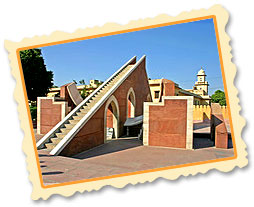 There
are plenty of observatories all over the world, but the Jantar Mantar
is considered to be one of the largest observatories ever built.
Combining religion, science and art, the Jantar Mantar is the name given
to a series of five, magnificent structures built in Jaipur, New Delhi,
Ujjan, Varanasi and Mathura. Jaipur was the seat of Maharaja Jai Singh
II during the 1720's and this is when this magnificent structure was
built here. The Jantar Mantar in Jaipur is considered to be the largest
of the five observatories and also houses the world's largest sundial.
The Universe and the Cosmos have always been of interest to man, and it
was this interest that compelled the Maharaja to build an astronomical
observatory. The term 'Jantar Mantar' is derived from the Sanskrit terms
'Yantra' and 'Mantra' meaning 'instruments' and 'formula' respectively.
The term 'Yantra' was replaced with 'Jantar' which means 'magical'. The
Jantar Mantar houses various architectural and astrological instruments
that have caught the interests of astronomers, historians and
architects around the world.
There
are plenty of observatories all over the world, but the Jantar Mantar
is considered to be one of the largest observatories ever built.
Combining religion, science and art, the Jantar Mantar is the name given
to a series of five, magnificent structures built in Jaipur, New Delhi,
Ujjan, Varanasi and Mathura. Jaipur was the seat of Maharaja Jai Singh
II during the 1720's and this is when this magnificent structure was
built here. The Jantar Mantar in Jaipur is considered to be the largest
of the five observatories and also houses the world's largest sundial.
The Universe and the Cosmos have always been of interest to man, and it
was this interest that compelled the Maharaja to build an astronomical
observatory. The term 'Jantar Mantar' is derived from the Sanskrit terms
'Yantra' and 'Mantra' meaning 'instruments' and 'formula' respectively.
The term 'Yantra' was replaced with 'Jantar' which means 'magical'. The
Jantar Mantar houses various architectural and astrological instruments
that have caught the interests of astronomers, historians and
architects around the world.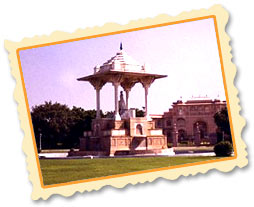 Jaipur
city offers a number of interesting tourist spots and one among them is
the famous Statue Circle. Located at a busy traffic junction, the
Statue Circle in Jaipur city has been a central place through which
almost half of the city's population passes while navigating through
this Pink City. Statue Circle is a popular hang-out spot in Jaipur and
the most famous circle known in the Pink City. The lovely ambience of
this famous circle offers a perfect place to hang around and enjoy the
pleasant breeze of the evening air. Its brilliant lightings and dazzling
fountains add up to the liveliness and vibrancy of the place. There are
numbers of rich local delicacies and spicy snacks which are served by
the vendors here. Besides being a famous tourist and picnic spot, the
Statue Circle also serves as a favorite place for evening walkers,
morning joggers, etc.
Jaipur
city offers a number of interesting tourist spots and one among them is
the famous Statue Circle. Located at a busy traffic junction, the
Statue Circle in Jaipur city has been a central place through which
almost half of the city's population passes while navigating through
this Pink City. Statue Circle is a popular hang-out spot in Jaipur and
the most famous circle known in the Pink City. The lovely ambience of
this famous circle offers a perfect place to hang around and enjoy the
pleasant breeze of the evening air. Its brilliant lightings and dazzling
fountains add up to the liveliness and vibrancy of the place. There are
numbers of rich local delicacies and spicy snacks which are served by
the vendors here. Besides being a famous tourist and picnic spot, the
Statue Circle also serves as a favorite place for evening walkers,
morning joggers, etc.